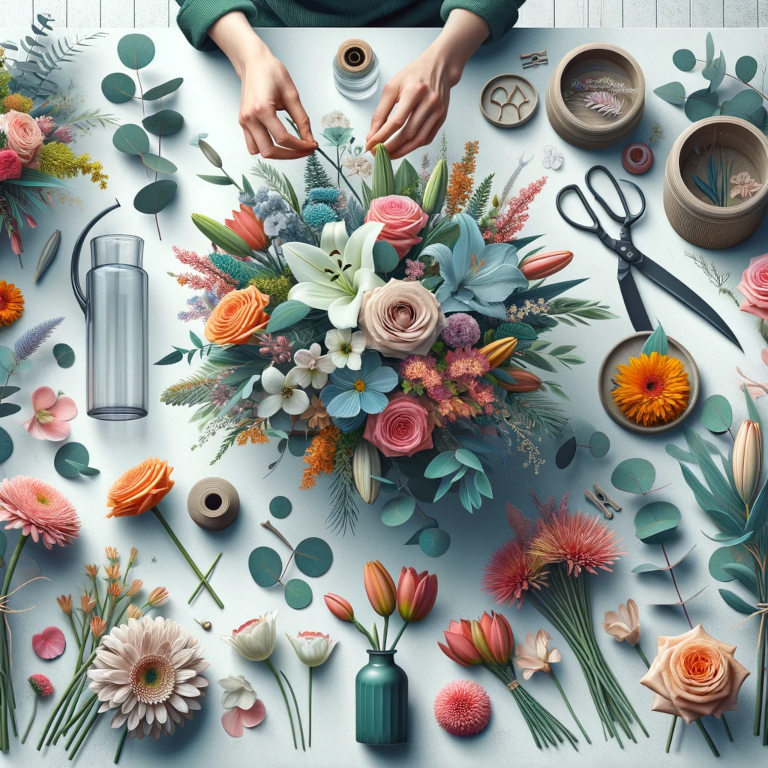Creating your own flower arrangements can be a rewarding and therapeutic activity, allowing you to bring a touch of natural beauty into your home. Whether you’re preparing for a special occasion or simply want to brighten up your living space, DIY flower arrangements offer endless possibilities for creativity and personalization. As an expert in DIY and Crafts, I will guide you through the process of making stunning flower arrangements, offering tips, techniques, and inspiration.
Understanding DIY Flower Arrangements
DIY flower arrangements involve selecting, cutting, and arranging flowers in a harmonious and aesthetically pleasing manner. This process includes choosing the right flowers, understanding color theory, and mastering basic floral design principles. With a little practice and creativity, anyone can create beautiful floral displays.
Benefits of DIY Flower Arrangements
- Personalization: DIY flower arrangements allow you to create designs that reflect your personal style and preferences. You can choose flowers that hold special meaning or match the decor of your space.
- Cost-Effective: Making your own arrangements can be more affordable than purchasing pre-made ones from a florist. You have control over the materials and can find budget-friendly options.
- Therapeutic: Working with flowers can be a calming and therapeutic activity. The process of arranging flowers can reduce stress and promote mindfulness.
- Creative Expression: Flower arranging is a form of art that offers endless opportunities for creativity. You can experiment with different colors, textures, and shapes to create unique designs.
Key Components of DIY Flower Arrangements
- Flower Selection: Choose a variety of flowers that complement each other in color, shape, and size. Consider the seasonality of flowers, as seasonal blooms are often fresher and more affordable. Popular choices include roses, lilies, tulips, daisies, and peonies.
- Color Theory: Understanding color theory can help you create harmonious arrangements. Complementary colors (colors opposite each other on the color wheel) create vibrant contrasts, while analogous colors (colors next to each other on the color wheel) offer a more harmonious look.
- Texture and Shape: Incorporate different textures and shapes to add depth and interest to your arrangement. Mix delicate blooms with sturdy foliage, and include a variety of flower shapes, such as round, spiky, and cascading.
- Filler and Foliage: Use filler flowers and foliage to add volume and structure to your arrangement. Common fillers include baby’s breath, eucalyptus, and ferns. Foliage can also provide a green backdrop that highlights the main blooms.
- Vase Selection: Choose a vase that complements your arrangement. The size and shape of the vase should match the style of your design. Clear glass vases are versatile and showcase the stems, while decorative vases can add a touch of elegance.
Steps to Create a DIY Flower Arrangement
- Prepare Your Materials: Gather all the necessary materials, including flowers, foliage, scissors or floral shears, a vase, floral tape or foam, and water.
- Trim the Stems: Trim the stems of your flowers and foliage at a 45-degree angle. This allows for better water absorption. Remove any leaves that will be below the water line to prevent bacterial growth.
- Create a Base: Start by creating a base with foliage or filler flowers. This will provide structure and support for the main blooms. Arrange the base foliage in a crisscross pattern to create a grid.
- Add the Main Blooms: Insert the main flowers into the arrangement, spacing them evenly and varying the heights for a natural look. Place larger blooms at the center or focal point and smaller blooms around them.
- Fill in Gaps: Use filler flowers to fill in any gaps and add volume. Ensure that the arrangement looks balanced from all angles.
- Adjust and Refine: Step back and evaluate your arrangement. Make any necessary adjustments to achieve the desired look. Trim any stems that are too long and reposition flowers as needed.
- Water and Care: Fill the vase with fresh water and add flower food if available. Change the water every few days and trim the stems to keep the flowers fresh longer.
Tips for Successful DIY Flower Arrangements
- Use Fresh Flowers: Choose the freshest flowers possible to ensure your arrangement lasts longer. Look for flowers with firm petals and vibrant colors.
- Consider the Environment: Place your arrangement in a cool area away from direct sunlight, heat sources, and drafts to prolong the life of the flowers.
- Experiment with Styles: Don’t be afraid to experiment with different styles and techniques. Try creating asymmetrical arrangements, monochromatic designs, or using unconventional containers.
- Keep Learning: Continue to learn and improve your skills by watching tutorials, reading books on floral design, and attending workshops.
- Practice Patience: Flower arranging is an art that requires patience and practice. Enjoy the process and take your time to create something beautiful.
Summary
DIY flower arrangements offer a wonderful way to express creativity, personalize your space, and enjoy the therapeutic benefits of working with flowers. By understanding the basics of floral design, selecting the right materials, and following simple steps, you can create stunning arrangements for any occasion. Embrace the joy of flower arranging and let your creativity bloom.






